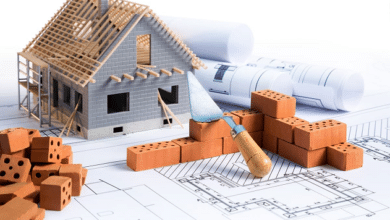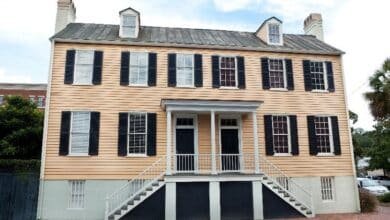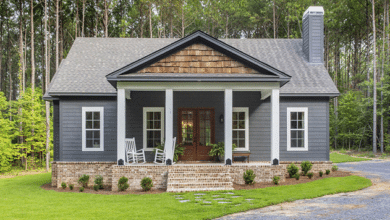Shed Roof Advantages and Disadvantages – Pros and Cons Explained

Shed Roof Advantages and Disadvantages
A shed roof design may come to mind when you think about creating a versatile, energy-efficient, and budget-friendly structure. Known for its simplicity and sleek design, the shed roof, a skillion or mono-pitch roof, has gained popularity in residential, commercial, and industrial architecture. But what makes a shed roof design unique, and what are the potential pros and cons?
This detailed exploration of shed roof advantages and disadvantages will cover everything you need to know. By understanding the benefits and potential drawbacks, you’ll be better equipped to decide if this design is right for your next project.
Key Advantages and Disadvantages of Shed Roofs
| Advantages | Disadvantages |
| Cost-effective and requires less material | Limited insulation options |
| Simple design, easy to construct | Susceptible to wind and weather stress |
| Allows for excellent natural lighting | Reduced attic or storage space |
| It provides a modern and stylish look | Drainage can be challenging with low pitch |
| Great for water drainage with steep pitch | Potential noise from rain or hail |
Key Advantages of Shed Roofs
Cost-Effective and Material Efficient
One of the standout features of a shed roof is its affordability. The single-slope design, with no complex angles or multiple slopes, reduces the required building materials. This simplicity also reduces labor time, making shed roofs a top choice for those seeking a budget-friendly construction option.
- Lower Material Costs: The single-pitch design uses fewer materials than more complex roof types, directly reducing expenses.
- Reduced Labor: Less time is required for shed roof installation, minimizing labor costs.
- Lower Maintenance Costs: Shed roofs are generally easy to maintain, as they lack intricate structural components that require frequent repairs.
Simple Design for Easy Construction
Thanks to its straightforward design, a shed roof is simple and fast to construct, whether by professional builders or DIY enthusiasts. The uncomplicated structure speeds up building time, reduces the risk of errors, and minimizes installation complexities. A shed roof provides a highly approachable solution for those who want a functional and streamlined design.
| Feature | Benefit |
| Single-slope structure | Minimal structural complexity |
| Suitable for DIY projects | Shortens construction time and reduces labor |
| Fewer materials required | Budget-friendly and eco-friendly choice |
Optimal Natural Lighting for Indoor Spaces
The sloping design of a shed roof can be strategically positioned to allow maximum natural lighting. By adding windows to the high side of the wall, shed roofs can let in sunlight throughout the day, especially if positioned to capture north-facing indirect light. Natural lighting can enhance the interior space, creating a warm ambiance while reducing energy costs associated with artificial lighting.
- Energy Efficiency: Natural light reduces dependency on artificial lighting, potentially lowering electricity bills.
- Health and Aesthetic Benefits: Sunlight enhances interior comfort and appeals to various architectural styles.
Contemporary Aesthetic and Versatile Design
A shed roof is an excellent choice for modern, sleek architectural styles. Its asymmetrical look adds a unique touch, contrasting with traditional roof types like gable or hip roofs. Shed roofs lend themselves well to contemporary aesthetics, making them popular for urban homes, studios, and even small commercial spaces.
Superior Water Drainage Capabilities (with Steep Pitch)
When designed with an appropriate pitch, shed roofs direct water away from the building. This is especially beneficial in rainy climates, where water drainage is essential to prevent leaks and roof damage. A steep-pitch shed roof directs water quickly to the ground, reducing pooling risk and improving the roof’s durability.
Drawbacks of Shed Roofs
Limited Insulation Flexibility
Shed roofs can present challenges in insulation, particularly when designed with a steep pitch. The lack of available attic space and limited interior headroom can restrict insulation installation, potentially impacting the building’s temperature regulation. Insufficient insulation can lead to heat loss in the winter and overheating during the summer.
- Energy Efficiency: Temperature regulation can be more difficult, potentially leading to higher heating and cooling costs.
- Insulation Options: Options such as rigid and spray foam insulation may be needed, but they can be costly or require professional installation.
Vulnerability to Wind and Extreme Weather
While a shed roof can be excellent for water drainage, its design may be more vulnerable to wind pressure, particularly in regions with strong winds or hurricanes. The single-pitch structure can act as a wind catchment area, exerting stress on the structure, especially if not installed with reinforced framing. In regions with extreme weather, shed roofs may require additional support to withstand wind and snow loads.
| Challenge | Description |
| Wind Pressure | Sloped design creates pressure points in wind |
| Uneven Snow Accumulation | Snow may accumulate unevenly, adding weight |
| Maintenance | Requires regular inspection for weather damage |
Limited Storage or Attic Space
Due to its sloped, single-surface design, a shed roof often doesn’t allow for an attic, significantly limiting storage options. This could be a disadvantage for those who need additional storage, as shed roofs do not typically support an overhead attic or loft area.
- Reduced Storage: Lack of attic space can limit storage potential in residential buildings.
- Minimal Headroom: Limited headroom reduces the overall usability of the roof’s interior area.
Drainage Concerns for Low-Pitched Shed Roofs
While steep-pitch shed roofs offer effective water drainage, low-pitch designs can experience pooling issues. A low slope may not drain water efficiently in areas prone to heavy rainfall, leading to leaks, mold growth, and potential structural damage over time. Proper drainage solutions are essential for low-pitch shed roofs to mitigate these risks.
Noise Sensitivity During Rain and Hail
The materials often used for shed roofs, like metal or thin panels, can amplify the sound of rain and hail, making it noisy during storms. This may be a drawback for those sensitive to noise or looking to create a quiet indoor environment. Fortunately, soundproofing options can help alleviate this issue.
Common Applications of Shed Roofs
The versatility of shed roofs makes them suitable for a variety of structures, each benefitting uniquely from the roof’s design:
- Residential Homes and Extensions: Shed roofs add a modern look to houses and are ideal for extensions, allowing for increased natural light.
- Workshops and Garages: The simplicity and ease of construction make shed roofs popular for workshops and garages.
- Greenhouses: Their ability to allow ample natural light makes them ideal for greenhouse structures.
- Commercial Spaces: Retail shops and small offices often use shed roofs for a sleek, contemporary aesthetic.
Each of these applications benefits from a shed roof’s simplicity, natural light, and stylish appeal. However, it’s crucial to consider the climate, local building codes, and personal preferences before finalizing your decision.
Cost Considerations for Shed Roofs
The shed roof design offers initial cost savings and can provide a good return on investment with its minimal maintenance needs. Here’s a breakdown of the cost factors you might consider when opting for a shed roof.
| Factor | Initial Cost | Long-Term Cost |
| Materials | Low due to minimalistic design | Potential insulation upgrades |
| Labor | Lower due to straightforward installation | Minimal, with proper installation |
| Energy Savings | Natural lighting reduces electric costs | Potential insulation upgrades, if required |
| Maintenance | Low with a steep pitch for water drainage | Occasional inspection for weather damage |
Sustainable Benefits of Shed Roofs
Shed roofs can offer eco-friendly benefits due to reduced material use, enhanced natural lighting, and suitability for renewable energy sources, like solar panels. However, optimizing insulation is essential for maximizing the roof’s energy efficiency, especially in colder climates.
- Reduced Resource Usage: Shed roofs require fewer materials, minimizing environmental impact.
- Natural Lighting Efficiency: The sloping design allows for abundant natural lighting, decreasing artificial light dependency.
- Compatibility with Solar Panels: The slope can easily accommodate solar panels for renewable energy use.
Frequently Asked Questions (FAQs) Shed Roof Advantages and Disadvantages
Q: How do shed roofs perform in snowy climates?
A: Shed roofs with a steep slope are effective for snow removal as the snow can easily slide off. However, regions with heavy snowfall may require additional structural support to handle weight accumulation in certain areas.
Q: Do shed roofs leak more frequently than other roof types?
A: Not necessarily. Proper installation and an adequate slope allow shed roofs to shed water effectively. Low-pitch shed roofs, however, may require additional drainage solutions to prevent pooling.
Q: Are shed roofs suitable for installing solar panels?
A: Yes, shed roofs are ideal for solar panel installation. Their sloped design can be oriented to maximize sunlight exposure, making them highly efficient for solar energy.
Q: Can shed roofs be insulated effectively?
A: Yes, but the pitch and design may limit insulation options. Insulation methods like spray or rigid foam can provide good thermal resistance, but professional installation is recommended.
Q: How does the cost of a shed roof compare to a traditional gable roof?
A: Shed roofs are generally more affordable due to fewer materials and simpler installation. However, depending on the specific design, additional insulation or drainage solutions can increase costs.
Final Thoughts
Shed Roof Advantages and Disadvantages: Shed roofs are smart for those seeking a cost-effective, stylish, and sustainable roofing option. Their straightforward design and modern appeal suit various applications, from homes and workshops to greenhouses and retail spaces. By evaluating the shed roof’s advantages and understanding its potential limitations, you can make a confident, informed choice for your next building project. Whether you prioritize style, functionality, or sustainability, a shed roof offers a versatile, high-performance solution to meet your architectural needs.




